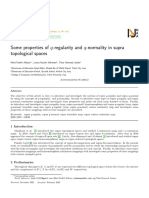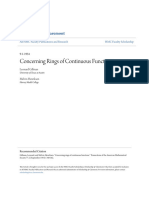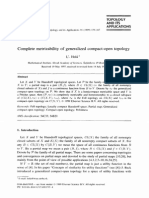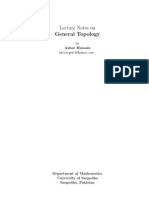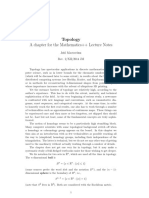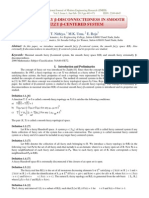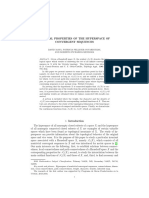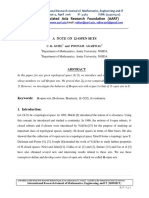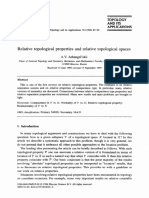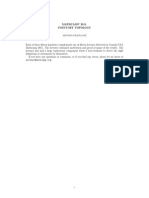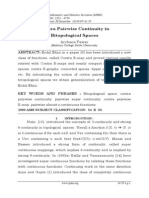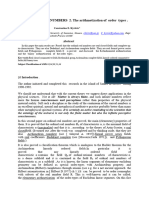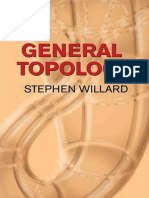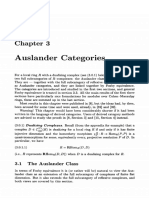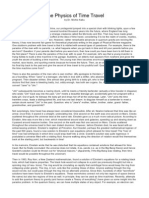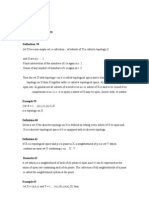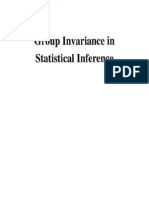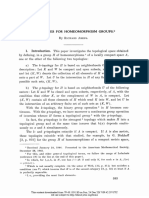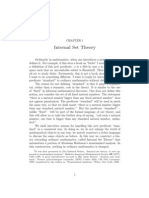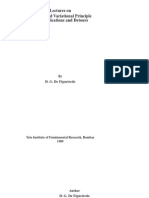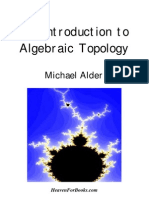A Class of Maximal Topologies (Douglas E. Cameron)
A Class of Maximal Topologies (Douglas E. Cameron)
Uploaded by
Sol AmorteguiCopyright:
Available Formats
A Class of Maximal Topologies (Douglas E. Cameron)
A Class of Maximal Topologies (Douglas E. Cameron)
Uploaded by
Sol AmorteguiOriginal Description:
Copyright
Available Formats
Share this document
Did you find this document useful?
Is this content inappropriate?
Copyright:
Available Formats
A Class of Maximal Topologies (Douglas E. Cameron)
A Class of Maximal Topologies (Douglas E. Cameron)
Uploaded by
Sol AmorteguiCopyright:
Available Formats
PACIFIC JOURNAL OF MATHEMATICS
Vol. 70, No. 1,1977
A CLASS OF MAXIMAL TOPOLOGIES
DOUGLAS E.
CAMERON
In this note, we characterize maximal topologies of a class of
topological properties which include lightly compact spaces and
QHC -spaces and, when restricted to completely regular spaces,
pseudocompact spaces. In addition we prove some results
relating maximal lightly compact and maximal pseudocompact
spaces.
A. B. Raha [12] has shown that maximal lightly compact spaces are
submaximal as are maximal pseudocompact spaces, and Douglas E.
Cameron [6] has characterized maximal QHC-spaces and shown these to
be submaximal. In Tychonof spaces, lightly compact and pseudocompact are equivalent; and in Hausdorff spaces, QHC and H-closed are
equivalent. We shall show that the maximal topologies of a class of
topologies which include lightly compact and QHC are submaximal and
Tj spaces.
The topological space with topology on set X shall be denoted by
(X, T), the closure of a subset A of X with respect to is cl and the
interior of A with respect to is intA, the complement of A with
respect to X is X A, the relative topology of r on A is r | A, and the
product of spaces (X, ) for a E 21 is (sX,
A topological space (X, r) with property R is maximal R if
whenever ' is stronger than ( ' D ) , then (X, r') does not have
property R. In [5] it was shown that for a topological property K, (X, r)
is maximal R if and only if every continuous bijection from a space (Y, r)
with property R to (X, r) is a homeomorphism. A topological space
(X, r) for which there exists a stronger maximal R topology is said to be
strongly R. For A C X the topology (A) with subbase r U{A} is the
simple expansion of r by A.
We shall restrict our study to topological properties which satisfy
some or all of the following:
P-l: contractive (preserved by continuous surjections)
P-2: regular closed hereditary
P-3: semi-regular (A topological property R is semi-regular if
(X, r) has property R if and only if (X, s ) has property R where s is the
semi-regularization of r.)
P-4: contagious (A topological property R is contagious if
101
102
DOUGLAS E. CAMERON
whenever a dense subset of a space has property JR, the entire space has
property JR [8]).
P-5: finitely unionable (If (X, r ) is a topological space, A, =X,
i = l,
, n are subsets which have property R, then U=1A, has
property R).
DEFINITION
1. Two topologies r and r ' o n X are ro-equivalent if
s = ' s .
THEOREM 1. An expansion ' of' is ro-equivalent to if and only if
c\T.U = clU for all U G r ' [10].
THEOREM 2. 1/ topological property R satisfies P-3, then a maximal R topology is submaximal.
Proof. This follows from the properties of P-3 and the fact that
every topological space has a stronger submaximal space with the same
semiregularization [3].
1. If a topological property R satisfies P-3, then maximal R topologies are TD.
COROLLARY
THEOREM 3. If topological property R satisfies P-l-P-5 a submaximal space (X, r) is maximal R if and only if for any A C X, such that both
X-intrA and A have property R, then A is closed.
Proof. If (X, T ) is submaximal and not maximal R, then there is
'Z> r such that 's^ s and (X, r') has property R. Therefore there is
U E T' such that cl U D clU and thus cl (7 is not -closed. cl 7 and
cl (X - c\U) are r ' regular closed and thus are r ' and r subspaces with
property JR.
By P-4, c l ( c l ( X - c l l / ) ) = c l ( X - c l ( 7 ) = X - i n t ( c l U ) has
property JR with respect to r.
If (X, T ) has property JR and there is a nonclosed subset A C X such
that both A and X - intA have property R, then the topology cl (X A ) has property R. Since every dense subset of a submaximal space is
open, ( X - A ) U i n t A is T open implying \B = ( X - A ) | B where
c l ( X - A ) = B. Also | A = ( X - A ) | A so both A and B are
(X-A)
subspac with property R and by P-5, ( X , ( X - A ) ) has
property R since X = A U B , thus (X, r ) is not maximal R.
COROLLARY 2. A submaximal space satisfying P-l-P-5 with property R in which every subspace with property R is closed is maximal R.
A CLASS OF MAXIMAL TOPOLOGIES
103
THEOREM 4. If property R satisfies P-l-P-5 and all one point sets
have property Ry then maximal R spaces are T.
Proof. Let ( X , r ) be submaximal R. If for XoEX,{x o } then
X - {x0} is r-dense therefore is open and so {x0} is closed. If {JC0} E r and
cl{x0}-int clT{jto} = 0 then since {x0} has property JR, cl {x0} - {y0}
has property R for y 0 ^ x0 by P-4. Since {y0} r, cl{y0} = {y0}, and the
free union of X - c l {x0}, {yo}, and cl{xo}-{yo} has property R and is
finer than (X, r ) which is a contradiction since (X, r ) is maximal R. If
cl{x0} ~ int cl{*o} / 0 , choose y0 E cl{x0} - int cl{x0}. Then A =
cl{xo}~{yo} has property R and is not closed. X - i n t A =
cl (X - cl A) is regular closed and thus has property R. By Theorem 3,
A is closed, a contradiction as {xo}C A$-cl{x0}.
5 If property R is productive and contractive (P-l) and
(X, %a) is maximal R, then (X, ) is maximal R for a E 31.
THEOREM
Proof. (X, ) has property JR for a E Si since R is contractive; if
(X, ) is not maximal R for some E SI, there is 'D such that
(X, T) has property R. Then for = for a^ , (rX, 9 ) has
property R which is a contradiction.
QHC-spaces (spaces for which every open cover has a finite
subcollection whose closures cover the space) have properties P-l-P-5
and have been studied in detail [6]. QHC-spaces which are Hausdorff
are called H-closed spaces. Lightly compact spaces (spaces for which
every countable open cover-has a finite subcollection whose closures
cover the space) satisfy P-l-P-5 (See [2] for P-2; [12] for P-3; P-l, P-4, and
P-5 are proven as for QHC). Lightly compact spaces are called feebly
compact in [14, 15]. Pseudocompact spaces satisfy P-l, P-3 [12], P-4 [8]
and P-5, but not P-2. However P-2 is satisfied for pseudocompactness in
the class of completely regular spaces [9] and maximal pseudocompact
spaces are Tx [7].
Spaces having properties P-P5 are not necessarily strongly JR
(QHC[6]; lightly compact[12]). However if -closed spaces are
strongly H-closed [10] and a first countable Hausdorff space which is
lightly compact is strongly lightly compact. This follows from P-3, the
fact that every space is coarser than some submaximal space with the
same semi-regularization, the fact that in a first countable Hausdorff
space, lightly compact subsets are closed (proven similarly to the same
result for first countable, T countably compact spaces [1]) and Corollary
2. In Tychonoff spaces pseudocompactness is closed hereditary [9], thus
we have the following result:
104
DOUGLAS E. CAMERON
THEOREM 6. A Tychonoff space is maximal pseudocompact if and
only if it is maximal lightly compact.
Proof. In completely regular spaces, pseudocompactness is equivalent to lightly compact [2]; since lightly compact spaces are pseudocompact then a lightly compact maximal pseudocompact space is maximal
lightly compact. If not maximal pseudocompact there is r ' D r such that
(X, T') is pseudocompact and therefore there is A E'-
such that
(X,(A)) is pseudocompact and is completely regular [13]. Therefore
(X, ( A ) ) is lightly compact.
REFERENCES
1. C. E. Aull, A certain class of topological spaces, Prace. Math., 11 (1967), 49-53.
2. R. W. Ragley, E. H. Connell and J. D. McKnight, Jr., On properties characterizing pseudocompact spaces, Proc. Amer. Math Soc, 9 (1958), 500-506.
3. Bourbaki, General Topology, Addison Wesley, (1966).
4. Douglas E. Cameron, Maximal pseudocompactness, Pro. General Topology Conf., Emory
University, (1970), 26-31.
5.
, Maximal and minimal topologies, Trans. Amer. Math. Soc, 160 (1971), 229-248.
6.
, Maximal QHC-spaces, Rocky Mountain J. Math., (to appear).
7.
, A note on maximal pseudocompactness, J. Australian Math. Soc, submitted.
8. J. Chew, Contagious properties, Math. Mag., (March 1974), 84-87.
9. I. Glicksberg, Stone-Cech compactifications of products, Trans. Amer. Math. Soc, 90 (1959),
369-382.
10. J. Miodurzewski and L. Rudolf, H-closed and extremely disconnected Hausdorff spaces,
Dissertationes Mathematical, 66 (1969).
11. J. R. Porter, and J. Thomas, On H-closed and minimal Hausdorff spaces, Trans. Amer. Math
Soc, 138 (1969), 159-170.
12. A. B. Raha, Maximal topologies, J. Australian Math. Soc, 15 (1973), 279-290.
13. D. F. Reynolds, Expansions of topologies by locally finite collections, Proc Gen. Top.
Conference, Charlotte (1974) Academic Press.
14. C. T. Scarborough and A. H. Stone, Products of nearly compact spaces, Trans. Amer. Math.
Soc, 124 (1966), 131-147.
15. R. M. Stephenson, Jr., Pseudocompact spaces, Trans. Amer. Math. Soc, 134 (1968), 437-448.
Received December 8, 1976 and in revised form January 31, 1977.
THE
UNIVERSITY OF AKRON
AKRON, OH 44325
AND
OHIO UNIVERSITY (visiting)
ATHENS, OH 45701
You might also like
- An Introduction To The Study of Stellar Structure (S. Chandrasekhar)Document508 pagesAn Introduction To The Study of Stellar Structure (S. Chandrasekhar)Sol Amortegui100% (1)
- M - SC - (Mathematics) - 311 14 - Topology - I PDFDocument264 pagesM - SC - (Mathematics) - 311 14 - Topology - I PDFLishii Ðë Lä Callë100% (1)
- Part III: Applications of Differential Geometry To PhysicsDocument88 pagesPart III: Applications of Differential Geometry To PhysicsKummerianNo ratings yet
- IJNAA Volume 13 Issue 2 Pages 95-101Document7 pagesIJNAA Volume 13 Issue 2 Pages 95-101فرات الطائيNo ratings yet
- Concerning Rings of Continuous FunctionsDocument24 pagesConcerning Rings of Continuous FunctionsShankar PediredlaNo ratings yet
- Assignment-2020 M.Sc. Mathematics (Eve) IV-Semester: PMAS Arid Agriculture University, RawalpindiDocument30 pagesAssignment-2020 M.Sc. Mathematics (Eve) IV-Semester: PMAS Arid Agriculture University, RawalpindiHamza ShafiqNo ratings yet
- G. T. CH 2Document28 pagesG. T. CH 2ZneNo ratings yet
- topology-class-1Document45 pagestopology-class-1shawonmulla12788No ratings yet
- Topology 464Document76 pagesTopology 464Zhang Xue PengNo ratings yet
- The Rings R (X) and R (X) : AndersonDocument20 pagesThe Rings R (X) and R (X) : Andersonchhiti.medNo ratings yet
- Complete Metrizability of Generalized Compact-Open TopologyDocument9 pagesComplete Metrizability of Generalized Compact-Open TopologyIrvin Fernando Mendoza RosadoNo ratings yet
- MSC General Topology Azhar HussainDocument20 pagesMSC General Topology Azhar HussainAmir AliNo ratings yet
- The Ring R (X)Document15 pagesThe Ring R (X)chhiti.medNo ratings yet
- Lecture Notes On General Topology: by Azhar HussainDocument20 pagesLecture Notes On General Topology: by Azhar Hussaingulfam100% (2)
- May Pel Pic 2Document26 pagesMay Pel Pic 2Mauricio Casarin PereaNo ratings yet
- On Weakly Ɣ-Normal SpacesDocument5 pagesOn Weakly Ɣ-Normal SpacesYhonnatan SalazarNo ratings yet
- Endomorphisms of R ( (X) ) Are EssentiallyDocument9 pagesEndomorphisms of R ( (X) ) Are EssentiallyMohamed KhalifaNo ratings yet
- Topology A Chapter For The Mathematics++ Lecture Notes: Ji R I Matou Sek Rev. 2/XII/2014 JMDocument68 pagesTopology A Chapter For The Mathematics++ Lecture Notes: Ji R I Matou Sek Rev. 2/XII/2014 JMANDRES DAVID GUEVARA MENDOZANo ratings yet
- Extremally Β-Disconnectedness In Smooth Fuzzy Β-Centered SystemDocument9 pagesExtremally Β-Disconnectedness In Smooth Fuzzy Β-Centered SystemIJMERNo ratings yet
- AW75 Connectedness and Disconnectedness in TopologyDocument25 pagesAW75 Connectedness and Disconnectedness in TopologyLorenzo MicheliniNo ratings yet
- General Properties of The Hyperspace of Convergent Sequences - D. Maya, P. Pellicer-Covarrubias and R. Pichardo-Mendoza 2018Document21 pagesGeneral Properties of The Hyperspace of Convergent Sequences - D. Maya, P. Pellicer-Covarrubias and R. Pichardo-Mendoza 2018grandfa grandfaNo ratings yet
- On Hausdorff Spaces Via Ideals and Semi-I-irresolute FunctionsDocument10 pagesOn Hausdorff Spaces Via Ideals and Semi-I-irresolute FunctionsAndres GuevaraNo ratings yet
- A Note On - OPEN Sets IrjmeitDocument9 pagesA Note On - OPEN Sets IrjmeitpoonamNo ratings yet
- Topology Chapter1Document13 pagesTopology Chapter1Aloke PramanikNo ratings yet
- Topological Mathematical PapersDocument3 pagesTopological Mathematical PapersDefinitely JunkieNo ratings yet
- Abstract.: ⊂ R for α ∈ µ, one can study the space E ∈ E, for each α ∈ µ) as a subspace of 'Document21 pagesAbstract.: ⊂ R for α ∈ µ, one can study the space E ∈ E, for each α ∈ µ) as a subspace of 'zaidi2009No ratings yet
- Metric and Me Triz Able SpacesDocument6 pagesMetric and Me Triz Able SpacesG.Daniel Sánchez MejiaNo ratings yet
- Seperation Spaces in TopologyDocument10 pagesSeperation Spaces in Topologysinxcosx75No ratings yet
- محاضرات مادة التبولوجي الكورس الاول1Document13 pagesمحاضرات مادة التبولوجي الكورس الاول1Abdul MuqtadirNo ratings yet
- A Short Proof of The Tietze-Urysohn Extension Theorem - Mark MandelkernDocument3 pagesA Short Proof of The Tietze-Urysohn Extension Theorem - Mark MandelkernandreNo ratings yet
- 1972 6158 1 SM PDFDocument12 pages1972 6158 1 SM PDFNaldo AndréNo ratings yet
- Topology Course Lecture NotesDocument49 pagesTopology Course Lecture NotesAlex LeeNo ratings yet
- δ Open Sets and δ Nano Continuity in δ Nano Topological SpaceDocument9 pagesδ Open Sets and δ Nano Continuity in δ Nano Topological SpaceInternational Journal of Innovative Science and Research Technology100% (2)
- Singularities of Holomorphic Foliations: To S. S. Chern & D. C. Spencer On Their 60th BirthdaysDocument64 pagesSingularities of Holomorphic Foliations: To S. S. Chern & D. C. Spencer On Their 60th BirthdaysandreNo ratings yet
- Homework2 PDFDocument2 pagesHomework2 PDFJuan RobinsonNo ratings yet
- Topological Properties of Function Spaces Over Ordinals - Saak GabriyelyanDocument5 pagesTopological Properties of Function Spaces Over Ordinals - Saak GabriyelyanGabriel medinaNo ratings yet
- Strong NanoDocument11 pagesStrong Nanosubha lakshmiNo ratings yet
- Ltheory and Novikov ConjectureDocument28 pagesLtheory and Novikov Conjecturegengtian.ncgNo ratings yet
- Weaktopologies PDFDocument20 pagesWeaktopologies PDFAqeelNo ratings yet
- Topological Spaces: SpaceDocument9 pagesTopological Spaces: SpaceJuwandaNo ratings yet
- The Weak Topology of Locally Convex Spaces and The Weak - Topology of Their DualsDocument11 pagesThe Weak Topology of Locally Convex Spaces and The Weak - Topology of Their DualsEDU CIPANANo ratings yet
- Articulo de ArhangelDocument13 pagesArticulo de ArhangelisoberanogonzalezNo ratings yet
- 2014 08 04 Closed Sets and Hausdorff SpacesDocument59 pages2014 08 04 Closed Sets and Hausdorff SpacesultimouniversoNo ratings yet
- ONSUPERCLASSESOFdelta OPENSETSINTOPOLOGICALSPACESDocument21 pagesONSUPERCLASSESOFdelta OPENSETSINTOPOLOGICALSPACESCarlos GranadosNo ratings yet
- OALibJ 2018081016225517Document7 pagesOALibJ 2018081016225517HonkiNo ratings yet
- Completeness Properties in Topological Spaces Having A Pair-BaseDocument14 pagesCompleteness Properties in Topological Spaces Having A Pair-BaseGALLEGO LUPIANEZNo ratings yet
- Separation Axioms 0Document20 pagesSeparation Axioms 0John SpencerNo ratings yet
- Point Set Topology From MathCamp 2011Document17 pagesPoint Set Topology From MathCamp 2011Tommy TangNo ratings yet
- Ijsred V2i5p57Document7 pagesIjsred V2i5p57IJSREDNo ratings yet
- GVN Nano Alpha OmegaDocument11 pagesGVN Nano Alpha Omegasubha lakshmiNo ratings yet
- CW ComplexesDocument6 pagesCW ComplexesBa NguyenNo ratings yet
- Contra Pairwise Continuity in Bitopological Spaces: Archana PawarDocument15 pagesContra Pairwise Continuity in Bitopological Spaces: Archana PawarinventionjournalsNo ratings yet
- Separation Axioms 2009 MalestromDocument4 pagesSeparation Axioms 2009 MalestromKhmer ChamNo ratings yet
- Golub G.H., Van Loan C.F. - Matrix ComputationsDocument19 pagesGolub G.H., Van Loan C.F. - Matrix ComputationsFranco Golfieri MadriagaNo ratings yet
- General Topology T. Tom Dieck 2011 PDFDocument85 pagesGeneral Topology T. Tom Dieck 2011 PDFEduar DoNo ratings yet
- ) - Supra Closed Set in Bi-Supra Topological Space: Australian Journal of Basic and Applied SciencesDocument11 pages) - Supra Closed Set in Bi-Supra Topological Space: Australian Journal of Basic and Applied Sciencesفرات الطائيNo ratings yet
- Ordinal Real Numbers2 Frangos Conference 12-11-23Document14 pagesOrdinal Real Numbers2 Frangos Conference 12-11-23Constantine KirichesNo ratings yet
- Topología General - WillardDocument380 pagesTopología General - WillardsiennaNo ratings yet
- A New Closure Operator Fort1mediotopologiesDocument6 pagesA New Closure Operator Fort1mediotopologiescontrerasbuitragojuanandres7No ratings yet
- 06auslander CategoriesDocument26 pages06auslander CategoriesPradeep SarodeNo ratings yet
- A Heuristic Way of Obtaining The Kerr Metric (Jorg Enderlein)Document6 pagesA Heuristic Way of Obtaining The Kerr Metric (Jorg Enderlein)Sol AmorteguiNo ratings yet
- What Is Model Theory (Jhonatan Kirby)Document2 pagesWhat Is Model Theory (Jhonatan Kirby)Sol AmorteguiNo ratings yet
- The Physics of Time Travel (Michio Kaku)Document2 pagesThe Physics of Time Travel (Michio Kaku)Sol AmorteguiNo ratings yet
- Braided Tensor CategoriesDocument6 pagesBraided Tensor CategoriesSol AmorteguiNo ratings yet
- Penrose OnTheNatureOfQuantumGeometryDocument29 pagesPenrose OnTheNatureOfQuantumGeometrySol Amortegui100% (1)
- Complex AnalysisDocument7 pagesComplex AnalysisJerome SadudaquilNo ratings yet
- TopologyDocument4 pagesTopologyrajawaqasNo ratings yet
- LP SolutionsDocument22 pagesLP Solutionsnitrosc16703No ratings yet
- Mathematical Methods in Quantum Mechanics - G. TeschlDocument255 pagesMathematical Methods in Quantum Mechanics - G. TeschlRaquel RodriguesNo ratings yet
- Math 553 - Topology Assignment 1: Todd RiggsDocument6 pagesMath 553 - Topology Assignment 1: Todd RiggsjohnNo ratings yet
- RW - Homeomorphism in Topological SpacesDocument3 pagesRW - Homeomorphism in Topological SpacesseventhsensegroupNo ratings yet
- Homework SolutionsDocument48 pagesHomework SolutionsemersonNo ratings yet
- TopologyDocument7 pagesTopologyEagle StalloneNo ratings yet
- MA260 MA222 Revision Guide 2023Document32 pagesMA260 MA222 Revision Guide 2023Lewis HaysNo ratings yet
- ExamDocument10 pagesExamRaid YebaraNo ratings yet
- Intro TopologyDocument7 pagesIntro TopologySamy YNo ratings yet
- AlgeomDocument41 pagesAlgeomLázaro AlbuquerqueNo ratings yet
- Neutrosophic TopologyDocument6 pagesNeutrosophic TopologyMia AmaliaNo ratings yet
- Topology MCQs 2Document6 pagesTopology MCQs 2Zain Ul AbidinNo ratings yet
- Group Invariance in Statistical Inference (Narayan)Document176 pagesGroup Invariance in Statistical Inference (Narayan)Lucas Pimentel Vilela100% (1)
- Very Elementary Proof of Invariance of Domain For The Real LineDocument3 pagesVery Elementary Proof of Invariance of Domain For The Real Line12temp12No ratings yet
- Full Chapter A Primer On Hilbert Space Theory Linear Spaces Topological Spaces Metric Spaces Normed Spaces and Topological Groups 2Nd Edition Carlo Alabiso Ittay Weiss PDFDocument54 pagesFull Chapter A Primer On Hilbert Space Theory Linear Spaces Topological Spaces Metric Spaces Normed Spaces and Topological Groups 2Nd Edition Carlo Alabiso Ittay Weiss PDFrichard.robison345100% (8)
- Arens-1946-Topologies For Homeomorphism GroupsDocument18 pagesArens-1946-Topologies For Homeomorphism GroupsGuido FranchettiNo ratings yet
- University of Durham: Topology of Robot Motion PlanningDocument46 pagesUniversity of Durham: Topology of Robot Motion PlanningJulio ArticaNo ratings yet
- A Class of Maximal Topologies (Douglas E. Cameron)Document4 pagesA Class of Maximal Topologies (Douglas E. Cameron)Sol AmorteguiNo ratings yet
- Internal Set TheoryDocument26 pagesInternal Set TheoryEpic WinNo ratings yet
- 331Document157 pages331SilviuNo ratings yet
- Solutions To Homework Problems: November 25, 2015Document48 pagesSolutions To Homework Problems: November 25, 2015Jeoff Libo-onNo ratings yet
- Integrability in Galois Graph Theory: O. Galileo, L. Jones, T. Shannon and W. MilnorDocument10 pagesIntegrability in Galois Graph Theory: O. Galileo, L. Jones, T. Shannon and W. MilnorAlessio MarchettiNo ratings yet
- Axioms 11 00194Document12 pagesAxioms 11 00194Ignacio Lopez ErazoNo ratings yet
- FIGUEIREDO - Lectures On The Ekeland Variational Principle WithDocument16 pagesFIGUEIREDO - Lectures On The Ekeland Variational Principle WithndtkhtnNo ratings yet
- Convexity and Well-Posed Problems (CMS Books in Mathematics) by Roberto LucchettiDocument321 pagesConvexity and Well-Posed Problems (CMS Books in Mathematics) by Roberto Lucchettima phaNo ratings yet
- Alder - An Introduction To Algebraic TopologyDocument142 pagesAlder - An Introduction To Algebraic Topologysticker592No ratings yet



